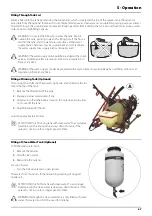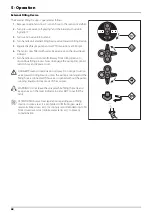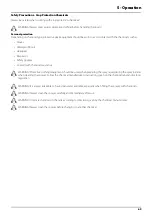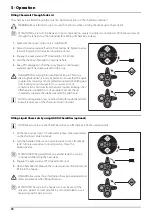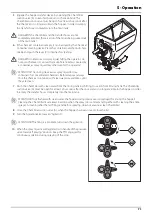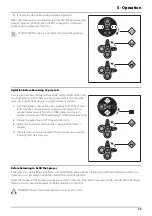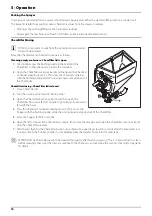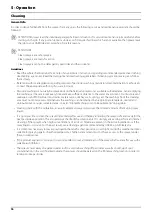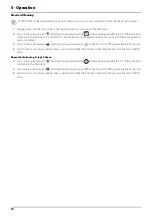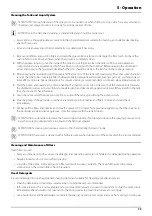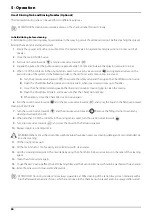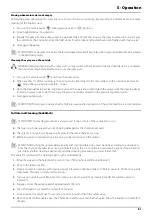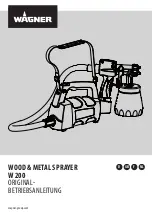
5 - Operation
79
Cleaning the Tank and Liquid System
μ
ATTENTION! Thorough cleaning of the sprayer is to be carried out when shifting to crops, which are very sensitive to
chemicals just sprayed, or prior to storage for a longer period of time.
÷
NOTE! Prior to the described cleaning, a standard cleaning should be carried out.
•
Select and use the appropriate protective clothing. Select detergent suitable for cleaning and suitable deactivating
agents if necessary.
•
Rinse and clean sprayer and tractor externally. Use detergent if necessary.
1.
Remove tank filters and suction filters and clean the sprayer. Be careful not to damage the filter mesh. Put back the
suction filter top. Put back all filters, when the sprayer is completely clean.
2.
With the pump running, rinse the inside of the tank. Do not forget to clean the tank roof. Rinse and operate all
components and any equipment, which have been in contact with the chemical. Before opening the distribution
valves and spraying the liquid out, decide whether this should be done in the field or on the seepage location.
3.
After spraying the liquid out, stop the pump and fill at least 1/5 of the tank with clean water. Note that some chemicals
require the tank to be completely filled. Add appropriate detergent and/or deactivating agent, e.g. washing soda or
triple effect ammonia. Special detergents for sprayer cleaning is recommended as some also lubricate ball valves etc.
4.
Start the pump and operate all controls enabling the liquid to come into contact with all the components. Operate
the distribution valves as the last thing. Some detergents and deactivating agents work best, if they are left in the tank
for a short period. Check the label.
5.
Drain the tank and let the pump run dry. Rinse inside of the tank, again letting the pump run dry.
6.
Stop the pump. If the pesticides used have a tendency to block nozzles and filters, remove and clean them
immediately.
7.
Put back all the filters and nozzles and store the sprayer. If it is noted, from previous experiences, that the solvents in
the pesticides are particularly aggressive, store the sprayer with the tank lid open.
μ
ATTENTION! It is advisable to increase the forward speed (double, if possible) and reduce the spraying pressure to 1.5
bar, when spraying diluted remaining liquid in the field just sprayed.
μ
ATTENTION! If a cleaning procedure is given on the chemical label, follow it closely.
μ
ATTENTION! If the sprayer is cleaned with a high pressure washer, lubrication of the entire machine is recommended.
Cleaning and Maintenance of Filters
Clean filters ensure:
•
Sprayer components such as valves, diaphragms and operating units are not hindered or damaged during operation.
•
Nozzle blockades do not occur whilst spraying.
•
Long life of the pump. A blocked suction filter will result in pump cavitation. The main filter protecting sprayer
components is the suction filter. Check it regularly.
Use of Detergents
It is recommended to use an appropriate cleaning detergent suitable for cleaning agricultural sprayers.
•
Cleaning detergents containing a suitable lube or conditioner are recommended.
•
If for some reasons this is not available, and e.g. triple ammonia water is used, it is important to rinse the spray circuit
immediately after and add some lubricant to the rinsing water to prevent ball valves etc. seizing up.
•
Use of automotive antifreeze/radiator coolant (ethylene glycol) will protect valves and seals from drying or seizing up.
Summary of Contents for NK MB Series
Page 8: ...1 Identification 8 ...
Page 52: ...3 Description 52 ...
Page 62: ...4 Sprayer Setup 62 ...
Page 84: ...5 Operation 84 ...
Page 87: ...6 Maintenance 87 Boom Lubrication Oiling Plan Lift Lubrication Oiling Plan ...
Page 116: ...9 EC Declaration 116 ...
Page 120: ...Index 120 ...
Page 122: ...HARDI INTERNATIONAL A S Helgeshøj Allé 38 DK 2630 Taastrup DENMARK ...



